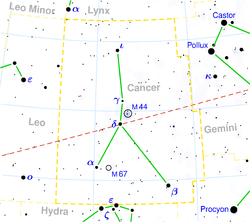Delta Cancri
 Asellus Australis is the central star in the "crab" | |
| Observation data Epoch J2000.0 Equinox J2000.0 | |
|---|---|
| Constellation | Cancer |
| Right ascension | 08h 44m 41.1s |
| Declination | +18° 09′ 15″ |
| Apparent magnitude (V) | +3.94 |
| Characteristics | |
| Spectral type | K0III |
| U−B color index | 0,99 |
| B−V color index | 1,08 |
| Variable type | unknown |
| Astrometry | |
| Radial velocity (Rv) | +17.14 km/s |
| Proper motion (μ) | RA: -17.67 mas/yr Dec.: -229.26 mas/yr |
| Parallax (π) | 24.98 ± 0.24[1] mas |
| Distance | 131 ± 1 ly (40.0 ± 0.4 pc) |
| Absolute magnitude (MV) | 0.824 |
| Other designations | |
| Database references | |
| SIMBAD | data |
Delta Cancri (δ Cancri, abbreviated Delta Cnc, δ Cnc), also named Asellus Australis,[2] is an orange giant star approximately 180 light-years from the Sun in the constellation of Cancer.
Since it is near the ecliptic, it can be occulted by the Moon and very rarely by planets.
Nomenclature
δ Cancri (Latinised to Delta Cancri) is the star's Bayer designation.
It bore the traditional name Asellus Australis which is Latin for "southern donkey colt". In 2016, the International Astronomical Union organized a Working Group on Star Names (WGSN)[3] to catalogue and standardize proper names for stars. The WGSN approved the name Asellus Australis for this star on 6 November 2016 and it is now so entered in the IAU Catalog of Star Names.[2]
It also has the longest of all known traditional star names, Arkushanangarushashutu, named such by the ancient Babylonians and which means "the southeast star in the Crab".[4]
In Chinese, 鬼宿 (Guǐ Su), meaning Ghost, refers to an asterism consisting of Delta Cancri, Theta Cancri, Eta Cancri and Gamma Cancri.[5] Consequently, Delta Cancri itself is known as 鬼宿四 (Guǐ Su sì, English: the Fourth Star of Ghost.)[6]
Observations
Delta Cancri was involved in the first recorded occultation by Jupiter:
"The most ancient observation of Jupiter which we are acquainted with is that reported by Ptolemy in book X, chap. iii (sic), of the Almagest, ...when the planet eclipsed the star known as (Delta) Cancri. This observation was made on September 3, B.C. 240, about 18h on the meridian of Alexandria."— Allen, 1898, quoting from Hind's The Solar System).
Delta Cancri also marks the famous open star cluster Praesepe (or the Beehive Cluster, also known as Messier 44). In ancient times M44 was used as a weather gauge as the following Greek rhyme from Aratos' Prognostica reveals:
A murky manger with both starsShining unaltered is a sign of rain.
While if the northern Ass is dimmed
By vaporous shroud, he of the south gleam radiant,
Expect a south wind: the vaporous shroud and radiance
Exchanging stars harbinger Boreas.
— Allen, 1898
The meaning of this verse is that if Asellus Borealis or Gamma Cancris[7] is hidden by clouds, the wind will be from the south and that situation will be reversed if Asellus Australis is obscured. There is some doubt however as to the accuracy of this as Allen notes: "Our modern Weather Bureau would probably tell us that if one of these stars were thus concealed, the other also would be." (Allen, 1898)
But Delta Cancri also acts as more than just a dubious weather guide: it is a reliable signpost for finding the vividly red star X Cancri as Patrick Moore notes in his guidebook Stars of the Southern Skies:
“In the same binocular field with Delta [Cancri] you will find one of the reddest stars in the sky: X Cancri. It is a semi-regular variable; at maximum it rises to magnitude 5 and it never falls below 7.3 so that it can always be seen with binoculars. It looks rather like a tiny glowing coal.”— Page 146, Moore, 1994.
Delta Cancri also marks the radiant of the Delta Cancrids meteor shower.
In 1876, the possibility of Delta Cancri having a companion star was proposed.[8]
See also
- Delta Cancrids (meteor shower)
References
- ↑ van Leeuwen, F. (November 2007), "Validation of the new Hipparcos reduction", Astronomy and Astrophysics, 474 (2): 653–664, arXiv:0708.1752
 , Bibcode:2007A&A...474..653V, doi:10.1051/0004-6361:20078357
, Bibcode:2007A&A...474..653V, doi:10.1051/0004-6361:20078357 - 1 2 "IAU Catalog of Star Names". Retrieved 21 November 2016.
- ↑ IAU Working Group on Star Names (WGSN), International Astronomical Union, retrieved 22 May 2016.
- ↑ Allen, Richard Hinckley, Star Names: Their Lore and Meaning, 1898.
- ↑ (Chinese) 中國星座神話, written by 陳久金. Published by 台灣書房出版有限公司, 2005, ISBN 978-986-7332-25-7.
- ↑ (Chinese) 香港太空館 - 研究資源 - 亮星中英對照表, Hong Kong Space Museum. Accessed on line November 23, 2010.
- ↑ Kaler, 2009:"ASELLUS BOREALIS".
- ↑ "The companion to delta Cancri". Astronomy Abstract Service. Retrieved June 1876. Check date values in:
|access-date=(help)
books
- Allen, Richard Hinckley, Star Names: Their Lore and Meaning, Dover, 1898.
- Burnham, Robert Jnr., Burnham's Celestial Handbook, Dover publications, 1978.
- Beresford Tony, Personal Communication (Letter on d Cancris.) 1997.
- Guinness, The Guinness Book of Records, Guinness Publishing, 1991.
- Kaler, James, B, ‘The Cambridge Encyclopaedia of Stars’, Cambridge University Press, 2006.
- Motz, Lloyd & Nathanson, Carol, Constellations, Aurum Press, 1991.
- Moore, Patrick, Atlas of the Universe, Phillips, 1994.
- Moore, Patrick, Stars of the Southern Skies, Penguin books, 1994.